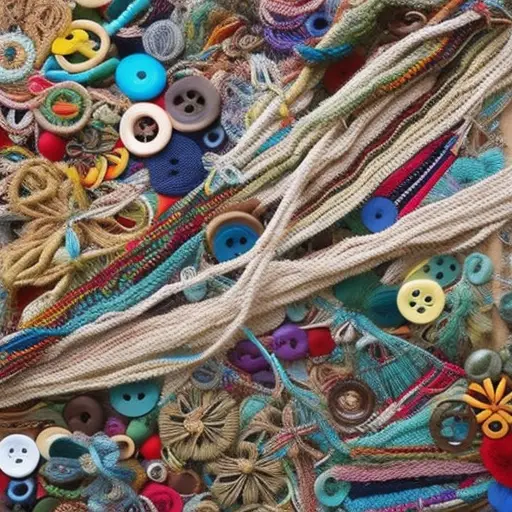Crafting With Sustainability in Mind

In the world of crafting, where creativity knows no bounds, sustainability is the guiding star that illuminates our path.
Like a gentle breeze weaving through the fibers of our projects, it whispers of the importance of using eco-friendly materials, repurposing with purpose, and embracing natural dyes.
With mindful waste management and sustainable packaging, we can create art that not only captivates the senses but also nurtures our planet.
Join us on this inspiring journey of crafting with sustainability in mind.
Incorporating Sustainable Materials
When crafting with sustainability in mind, it is essential to incorporate sustainable materials by using eco-friendly alternatives. One way to do this is by choosing sustainable fabric alternatives. Traditional fabrics, such as cotton and polyester, have a significant impact on the environment due to the amount of water, land, and chemicals required for production. However, there are now eco-conscious fabric options available that are made from organic cotton, hemp, bamboo, or even recycled materials. These materials not only reduce the environmental impact but also offer unique textures and patterns for your crafting projects.
Another important aspect of incorporating sustainable materials is considering the glue options used in crafting. Many conventional glues contain harmful chemicals that can be detrimental to both human health and the environment. However, there are now eco-friendly glue alternatives that are made from natural and non-toxic ingredients. These options, such as water-based adhesives or plant-based glues, not only provide a safe and sustainable alternative but also offer excellent adhesive properties for your crafting needs.
Repurposing for a Greener Craft
To further promote sustainability in crafting, repurposing materials is an effective way to reduce waste and create a greener craft. By giving new life to items that would otherwise end up in landfills, we can minimize our environmental impact and contribute to a more sustainable future. Here are three ways you can incorporate repurposing into your crafting practice:
-
Upcycling projects: Instead of throwing away old items, consider how they can be transformed into something new and useful. For example, you can turn glass jars into candle holders or transform old t-shirts into reusable shopping bags. The possibilities are endless, and upcycling allows us to showcase our creativity while reducing waste.
-
Sustainable craft supplies: When sourcing materials for your projects, opt for sustainable options. Look for supplies made from recycled or eco-friendly materials, such as recycled paper, organic fabrics, or reclaimed wood. By using sustainable craft supplies, we can support environmentally conscious businesses and minimize our carbon footprint.
-
Donations and swaps: If you have unused craft materials or finished projects that no longer serve you, consider donating them to local schools, community centers, or art programs. You can also participate in craft supply swaps with fellow crafters, allowing you to exchange materials and reduce waste collectively.
Natural Dyes for Vibrant Colors
Natural dyes offer an eco-friendly alternative to synthetic dyes, ensuring that our crafting endeavors are in line with sustainability principles.
These dyes are derived from plant-based sources, such as leaves, flowers, and roots, minimizing the ecological impact of the dyeing process.
Moreover, natural dyes provide a range of color options and variations, allowing crafters to create vibrant and unique pieces while staying true to their commitment to the environment.
Eco-Friendly Dye Alternatives
The use of eco-friendly dye alternatives, such as natural dyes, offers a sustainable and vibrant option for crafting with sustainability in mind. By opting for natural dyes, crafters can minimize their environmental impact while still achieving beautiful and vibrant colors.
Here are three eco-friendly dye techniques to consider:
-
Plant-based dyes: Extracted from plants like indigo, turmeric, and madder root, these dyes offer a range of colors that are both stunning and sustainable. By using plants that are easily renewable, crafters can reduce their carbon footprint.
-
Upcycled materials: Instead of purchasing new fabric, consider repurposing old clothing or textiles. By using upcycled materials, you not only reduce waste but also give new life to something that would have otherwise been discarded.
-
Non-toxic alternatives: Traditional synthetic dyes often contain harmful chemicals that can pollute waterways. Choose non-toxic alternatives like low-impact dyes or natural mordants, which are safer for both the environment and your health.
Benefits of Natural Dyes
One key advantage of using natural dyes for crafting is their ability to produce vibrant colors. Natural dyes are derived from plants, minerals, and insects, making them an eco-conscious choice for those who want to embrace a sustainable lifestyle. These dyes offer a range of beautiful hues that can add a touch of vibrancy to any craft project. From rich reds derived from madder roots to vibrant yellows obtained from turmeric, the possibilities are endless. By using natural dyes, crafters can create stunning pieces while minimizing their environmental impact. The table below showcases some popular natural dyes and their corresponding vibrant colors:
| Natural Dye | Vibrant Color |
|---|---|
| Madder Root | Rich Red |
| Turmeric | Vibrant Yellow |
| Indigo | Deep Blue |
With natural dyes, crafters can achieve vibrant colors while promoting sustainability in fashion and embracing an eco-conscious lifestyle.
Moving forward, let’s explore the various color options and variations available with natural dyes.
Color Options and Variations
Color options and variations in natural dyes provide a diverse palette for crafters seeking vibrant and sustainable hues. By opting for eco-friendly color palettes, crafters can reduce their environmental impact while still creating beautiful and unique pieces.
When considering sustainable fabric choices, it’s important to choose materials that can easily absorb natural dyes, such as organic cotton or linen. These fabrics not only provide a better canvas for vibrant colors but also have a lower environmental footprint compared to synthetic alternatives.
Additionally, experimenting with different mordants and dyeing techniques can create endless possibilities for color variations, allowing crafters to unleash their creativity while staying true to their eco-conscious values. With a wide range of natural dyes available, from plant-based extracts to insect-derived pigments, crafters can achieve stunning results while promoting sustainability in their craft.
Transitioning from color options and variations, let’s now explore the importance of mindful waste management in crafting.
Mindful Waste Management in Crafting
Implementing mindful waste management practices is crucial for crafting projects that prioritize sustainability. By finding creative ways to reduce waste and upcycle materials, crafters can contribute to a more eco-friendly world. Here are some ideas to help you minimize crafting waste and make a positive impact on the environment:
| Reduce | Reuse | Repurpose | Recycle |
|---|---|---|---|
| Use precise measurements to minimize excess materials | Save and organize leftover craft supplies for future projects | Repurpose old materials into new creations | Recycle paper, cardboard, and other recyclable materials |
| Plan projects carefully to avoid unnecessary waste | Donate unwanted craft supplies to schools or community centers | Turn fabric scraps into patchwork projects or rag rugs | Look for recycling programs in your area for specific materials |
| Choose materials with minimal packaging or opt for bulk options | Turn packaging materials like cardboard boxes into storage solutions | Transform glass jars into candle holders or storage containers | Properly dispose of hazardous materials like paints and glues |
Eco-Friendly Packaging and Gift Wrapping Ideas
When it comes to eco-friendly packaging and gift wrapping, using recycled materials is a great way to reduce waste. Instead of traditional wrapping paper, consider using brown kraft paper or newspaper that can be easily recycled.
Additionally, explore natural dye alternatives, such as vegetable-based dyes, to add a touch of color to your packaging while minimizing the use of harmful chemicals.
Recycled Materials for Wrapping
Using recycled materials for wrapping presents is a sustainable and eco-friendly choice. By opting for upcycled fabric or paper alternatives, you can reduce waste and contribute to a greener planet. Here are three ideas for using recycled materials for wrapping:
-
Upcycled Fabric: Instead of using traditional wrapping paper, consider using old fabric scraps or repurposing old clothes to create unique and stylish gift wraps. This not only adds a personal touch to your presents but also reduces the demand for new materials.
-
Paper Alternatives: Explore alternatives to traditional wrapping paper, such as recycled kraft paper, newspaper, or even old maps. These options not only look chic but also help divert paper waste from landfills.
-
Nature’s Bounty: Embrace the natural beauty around you by using elements like leaves, twigs, or dried flowers to decorate your gifts. These biodegradable materials add a touch of elegance and can be easily composted after use.
Natural Dye Alternatives
To achieve eco-friendly packaging and gift wrapping, consider incorporating natural dye alternatives. Instead of using synthetic dyes that contribute to pollution, opt for plant-based pigments that are derived from natural sources such as fruits, vegetables, and flowers.
These natural dyes not only offer vibrant and unique colors but also have a lower environmental impact. There are various dyeing techniques that can be employed to create beautiful and sustainable packaging and gift wrapping.
For example, you can try using the tie-dye or shibori technique to create intricate patterns and designs. Additionally, you can experiment with eco-printing, which involves directly imprinting plant materials onto fabric or paper.
Supporting Ethical and Local Craft Suppliers
One key way to promote sustainability in crafting is by supporting ethical and locally sourced craft suppliers. By choosing to purchase materials from suppliers who prioritize ethical sourcing and fair trade practices, crafters can ensure that their creations have a positive impact on both people and the planet. Here are three reasons why supporting ethical and local craft suppliers is important:
-
Promotes Fair Trade: Ethical sourcing and fair trade practices ensure that the artisans and workers involved in the production of craft materials are paid fair wages and work in safe conditions. By supporting these suppliers, crafters contribute to the empowerment and well-being of these individuals, helping to break the cycle of poverty and exploitation.
-
Reduces Environmental Impact: Local craft suppliers often use sustainable and eco-friendly production methods, such as using natural dyes, organic materials, and reducing waste. By purchasing from them, crafters can minimize their environmental footprint and contribute to the preservation of natural resources.
-
Supports Local Communities: When crafters support local suppliers, they help to strengthen the local economy and preserve traditional craft techniques. This, in turn, helps to maintain cultural diversity and heritage, as well as create employment opportunities within the community.
Frequently Asked Questions
How Can I Ensure That the Sustainable Materials I Use for Crafting Are Actually Eco-Friendly?
To ensure the sustainability of materials used for crafting, one must prioritize sourcing sustainable materials and identifying eco-friendly suppliers. This approach promotes responsible consumption and production, contributing to a more environmentally conscious and inspiring crafting practice.
Are There Any Specific Guidelines or Certifications to Look for When Purchasing Repurposed Materials?
Are there specific guidelines or certifications to look for when purchasing repurposed materials? It is essential to prioritize sustainability by seeking certifications such as Fair Trade, Cradle to Cradle, or Green Seal and following guidelines set by organizations like the Sustainable Furnishings Council.
What Are Some Natural Alternatives to Chemical Dyes That Can Still Create Vibrant Colors in My Crafts?
Natural dye sources such as plants, fruits, and insects can be used as alternatives to chemical dyes in crafting. By experimenting with different techniques and mordants, vibrant colors can still be achieved while being mindful of the environment.
How Can I Effectively Manage Waste While Crafting at Home?
Reducing waste and implementing upcycling techniques are key to effectively managing waste when crafting at home. By reusing materials, repurposing items, and minimizing single-use products, we can create a more sustainable and eco-friendly crafting process.
Are There Any Eco-Friendly Alternatives to Traditional Gift Wrapping Materials That Still Look Beautiful and Presentable?
There are many eco-friendly alternatives to traditional gift wrapping materials that still look beautiful and presentable. Sustainable crafting materials such as recycled paper, fabric, or even plant-based materials can be used to create unique and environmentally friendly gift wrap options.
Conclusion
Incorporating sustainable materials, repurposing items, and using natural dyes are just a few ways to craft with sustainability in mind. Mindful waste management and eco-friendly packaging ideas further contribute to reducing our environmental impact.
By supporting ethical and local craft suppliers, we can ensure that our crafting practices align with our values. Let us embrace these eco-conscious choices and inspire others to do the same, creating a more sustainable future through our crafting endeavors.




